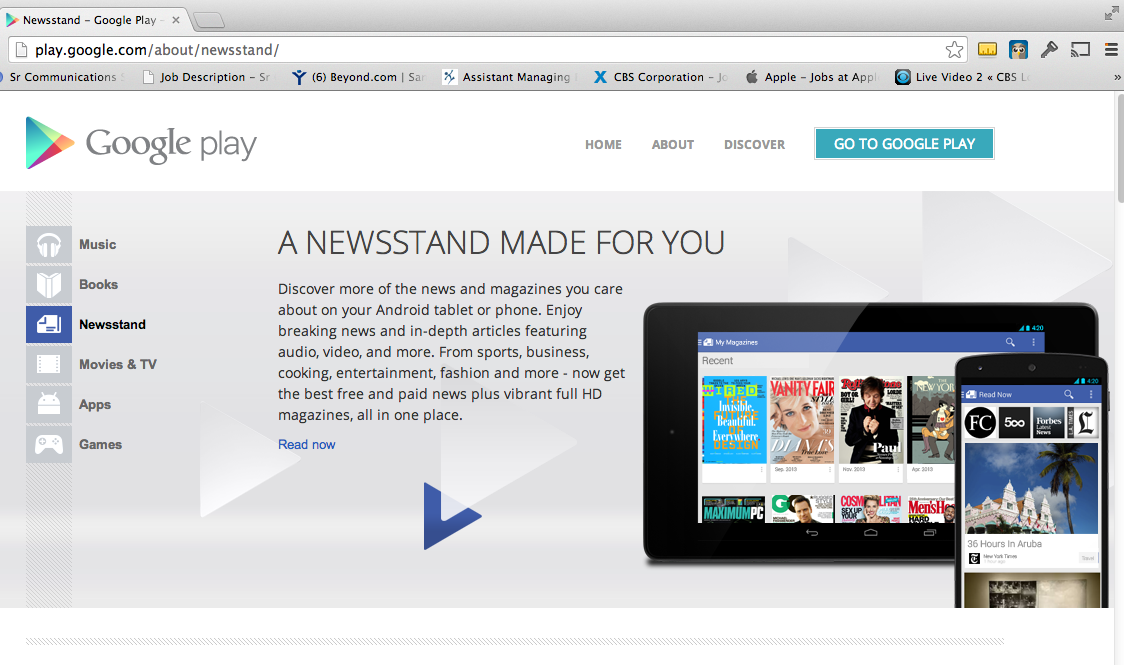Google introduced its latest platform for consuming news on Android devices today, suggesting that news organizations’ native apps aren’t serving readers well — even as those apps continue to be offered in the Google Play Store.
The new Google Play Newsstand replaces Android’s Magazine and Currents apps and promises one central home for magazine and newspaper subscriptions on smartphones and tablets.
But fear not: This has nothing in common with Apple’s much-maligned and same-named Newsstand, which is little more than a forced hub for certain news apps. Rather, the Google Play Newsstand is an app itself, a Flipboard-style reader with content from major publications like the Chicago Tribune and free blogs like the Verge. Crucially — and here’s how it separates itself from Currents — Newsstand allows for paid, subscription-based access, bringing paywall publishers like The New York Times and The Wall Street Journal into the fold.
It’s a nice, simple way to consume newspaper and magazine content on Android devices, and it aims to learn what kind of content you’re interested in so it can help you customize which feeds you see. Still, it’s not quite the one-stop shop for news that it purports to be in a blog post:
“Staying up on the news can be a daunting task. You have to go to a different website or app for each of your favorite magazines, newspapers and blogs. One place to read and discover all of this would be a lot simpler.”
But here’s the thing: Those separate apps still exist inside the Google Play Store, and some of them, like the Journal, offer more robust features than Newsstand does. Moreover, some news organizations, like the Chicago Sun-Times (where I used to work), haven’t joined Newsstand yet, so you can only get its content via apps or the web.

- Viewed on a 2012 Nexus 7, the Wall Street Journal in Google Play Newsstand, left, and in its native Android app, right.
So what’s the play here, if you’ll pardon the pun? Is Google hoping to steer news organizations away from native news apps altogether and bring all news content under one roof on Android?
As it stands, the different roofs are confusing. If a reader sees Newsstand and assumes that’s where she should search for the Sun-Times, she won’t find the newspaper’s native app, which only appears if you search the entire Play Store or only the store’s app section. Meanwhile, a reader looking for The Wall Street Journal sees two options: one in the Newsstand section and another in the apps section.
Michael Rolnick, head of digital at Dow Jones & Co., told Poynter via phone that the big advantage of Newsstand is that a large audience can stumble upon Journal content and sample it without downloading a separate app. If the Journal converts those readers to digital subscribers, it can point them to other products, like the app.
In that sense, the two platforms could be complementary, especially because the Journal’s app — which mimics print in terms of story selection and design — offers an experience distinct from what’s offered by Newsstand (although the Journal’s app is a much clunkier experience on lower-end Android tablets than it is on the iPad).

- Viewed on a 2012 Nexus 7, the New York Times in Google Play Newsstand, left, and in its native Android app, right.
The New York Times in Newsstand, meanwhile, mimics the Times app to the extent that it nearly renders the app redundant. So I wouldn’t be surprised to see the Times abandon its native Android app in favor of a strong presence on Newsstand, which has the advantage of being a default app on new Android devices. And I’d expect smaller newspapers like the Sun-Times to start feeding content to Newsstand as well.
Why devote resources to maintaining a native app if Android offers a built-in platform that achieves much of the same functionality?







Comments